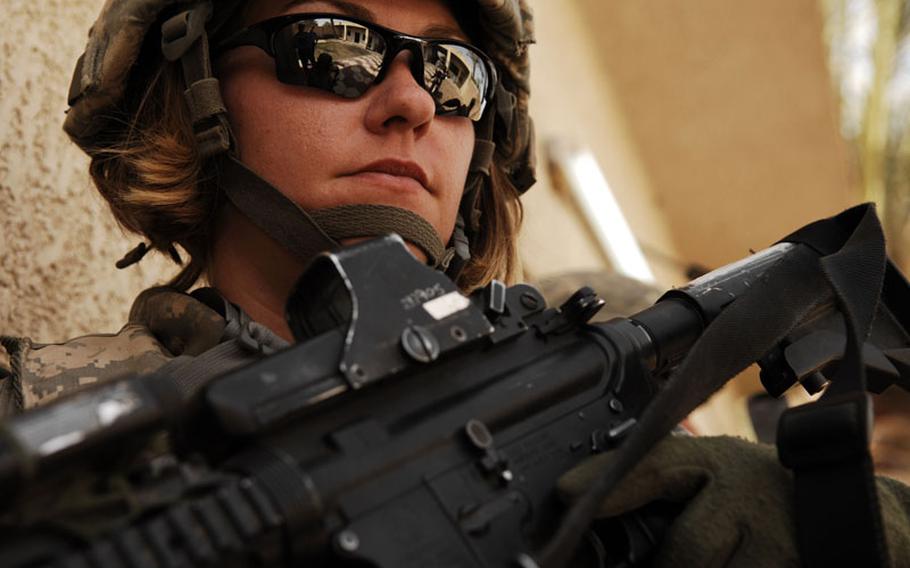
U.S. Army Spc. Rebecca Buck, a medic from Headquarters and Headquarters Company, 1st Battalion, 14th Infantry Regiment, 2nd Stryker Brigade Combat Team, 25th Infantry Division, provides perimeter security outside an Iraqi police station in the Tarmiya Province of Iraq, March 30, 2008. (William Greer/Courtesy U.S. Air Force)
WASHINGTON — Military leaders have thrown out the 1994 rule barring women from combat and asked the services to remove all unnecessary gender-based barriers in a move that could open about 237,000 new specialties and assignments to women.
“Female servicemembers have faced the reality of combat, proven their willingness to fight, and yes, to die, to defend their fellow Americans,” Defense Secretary Leon Panetta said Thursday. “However, many military positions, particularly in ground combat units, still remain closed to women.”
Visiting the war zone, meeting with troops and visiting wounded warriors, Panetta said, “I’ve been impressed with the fact that everyone, everyone, men and women alike, everyone is committed to doing the job. They’re fighting and they’re dying together. And the time has come for our policies to recognize that reality.”
Panetta, Chairman of the Joint Chiefs of Staff Gen. Martin Dempsey and leaders from each of the services have been working to remove the combat exclusion policy for more than a year, senior defense officials said, and the Joint Chiefs unanimously decided that now is the best time to act.
Under the combat exclusion policy, 53,000 positions were closed to women by unit — that is, women who hold the correct military occupational specialty could not be assigned to certain combat arms units. An additional 184,000 positions were closed by specialty.
Now, the services must quickly outline detailed plans for how to begin opening all of those jobs to women, and deliver those plans to Panetta or his successor by May 15.
In many cases, that will mean creating a gender-neutral physical standard for certain units or military occupational specialties, separate from the service’s physical fitness test. For example, tankers must be able to lift, rotate and load heavy ammunition in a very confined space, so a physical test for those jobs might measure a service member’s ability to perform that task, regardless of gender.
The services are not allowed to raise or lower physical standards for gender-specific reasons, a senior defense official said.
Having these standards will ensure that, regardless of gender, “the best individual will be serving in our Army in the future,” a senior Army official said. “This is actually good for both men and women because it will be very clear as to what they are supposed to do to accomplish the task of their job.”
If, after reviewing standards and physical requirements, a service wishes to keep a certain specialty or unit closed to women, the service chief must explain why and get express permission from the secretary of defense, senior defense officials said.
The integration is likely to be incremental, with some positions and specialties opening to women as early as this year — in time for more women to see combat in Afghanistan. However, the services they have until Jan. 1, 2016, to fully implement the change.
More than 280,000 women have deployed to Iraq and Afghanistan over the past decade, and women make up about 15 percent of the military force.
Though Panetta will soon leave his position as secretary of defense, senior defense officials rejected assertions that this move was an attempt to sneak in major changes in his last days in office.
“This was not a snap decision by the secretary of defense,” a senior defense official said. “He’s been working very closely with the service chiefs over a period of about a year… this decision was reached because the chiefs were ready to recommend to him that this rule be lifted.”
Last year, Panetta opened about 15,000 additional positions to women, “and this is a natural evolution” from that, the senior defense official said.
President Barack Obama said he was very pleased about the change.
“Today, every American can be proud that our military will grow even stronger with our mothers, wives, sisters and daughters playing a greater role in protecting this country we love,” he said in a written statement.
Zoe Bedell, a captain in the Marine Corps Reserve who served two tours in Afghanistan as an active-duty Marine, said she is “thrilled” about the change.
Bedell is one of four women who sued Panetta in November to remove the combat exclusion.
“Women are already doing this stuff,” she said. “They’re already out there, they’re patrolling, they’re in combat.”
Bedell said she knows that some women would prefer not to serve in combat roles, just as some men prefer not to serve in combat roles. But she said the change will strengthen the military by allowing commanders to put their people where they need them and train them appropriately.
“We’ve been asking for equality of opportunity,” she said. “We’ve been asking for women — and men — to be evaluated on whether they can do the job.”
That’s exactly what will happen now, a senior Marine official said.
“If they can do it, male or female, they can do it. If they can’t, they can’t,” he said.
Panetta agreed. “In life, as we all know, there are no guarantees of success. Not everyone is going to be able to be a combat soldier,” he said. “But everyone is entitled to a chance.”
hladj@stripes.osd.mil Twitter: @jhlad